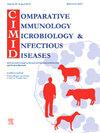Molecular characterization of Hyalomma scupense and its vector-borne pathogen Theileria annulata in Ksar El Boukhari (Medea, Algeria)
IF 2
3区 农林科学
Q4 IMMUNOLOGY
Comparative Immunology Microbiology and Infectious Diseases
Pub Date : 2024-09-27
DOI:10.1016/j.cimid.2024.102243
引用次数: 0
Abstract
This study analyzed the molecular and phylogenetic profiles of Theileria annulata, the causative agent of tropical theileriosis in cattle, and its tick vector Hyalomma scupense in Algeria. Forty H. scupense ticks were collected in Medea, with 5 testing positive for Theileria spp. based on partial COXIII gene sequences. Positive ticks were further analyzed using COX1 and 12S rRNA genes. Two novel H. scupense 12S rRNA haplotypes and one novel COX1 haplotype were identified. One T. annulata haplotype previously reported in Algerian cattle was detected. This represents the first molecular characterization of T. annulata from H. scupense ticks in Algeria, providing insights into the genetic diversity of the parasite vector in this region. Overall, the study reveals new haplotypes for both the tick vector and parasite, furthering our understanding of their molecular profiles and phylogenetics in Algeria.
Ksar El Boukhari(阿尔及利亚梅迪亚)Hyalomma scupense 及其媒传病原体 Theileria annulata 的分子特征。
本研究分析了阿尔及利亚热带牛皮癣菌病的病原体环纹丝菌及其蜱媒Hyalomma scupense的分子和系统发育概况。在梅迪亚(Medea)采集了 40 只褐斑蜱,根据 COXIII 基因的部分序列,5 只褐斑蜱的检测结果呈阳性。通过 COX1 和 12S rRNA 基因对阳性蜱进行了进一步分析。发现了两个新的 H. scupense 12S rRNA 单倍型和一个新的 COX1 单倍型。此外,还发现了一个之前在阿尔及利亚牛身上报道过的 T. annulata 单倍型。这是首次对阿尔及利亚 H. scupense 蜱中的 T. annulata 进行分子鉴定,有助于深入了解该地区寄生虫病媒的遗传多样性。总之,这项研究揭示了蜱媒和寄生虫的新单倍型,进一步加深了我们对阿尔及利亚蜱媒和寄生虫分子特征和系统发育的了解。
本文章由计算机程序翻译,如有差异,请以英文原文为准。
求助全文
约1分钟内获得全文
求助全文
来源期刊
CiteScore
4.60
自引率
0.00%
发文量
102
审稿时长
40 days
期刊介绍:
Comparative Immunology, Microbiology & Infectious Diseases aims to respond to the concept of "One Medicine" and to provide a venue for scientific exchange. Based on the concept of "Comparative Medicine" interdisciplinary cooperation between specialists in human and animal medicine is of mutual interest and benefit. Therefore, there is need to combine the respective interest of physicians, veterinarians and other health professionals for comparative studies relevant to either human or animal medicine .
The journal is open to subjects of common interest related to the immunology, immunopathology, microbiology, parasitology and epidemiology of human and animal infectious diseases, especially zoonotic infections, and animal models of human infectious diseases. The role of environmental factors in disease emergence is emphasized. CIMID is mainly focusing on applied veterinary and human medicine rather than on fundamental experimental research.

 求助内容:
求助内容: 应助结果提醒方式:
应助结果提醒方式:


